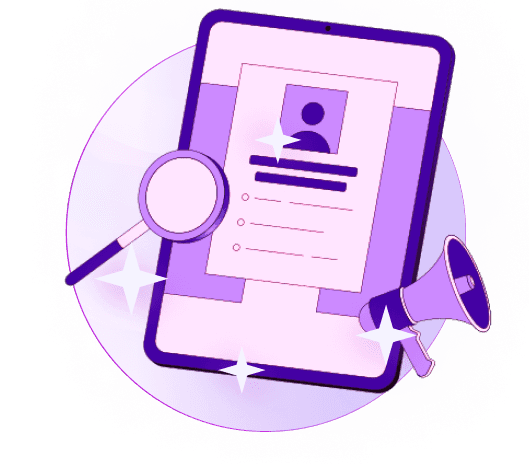Blogs
Articles

7 Types of Intent Data and How to Use Them Effectively
Did you know that 73% of B2B marketers currently implement intent data strategies in their businesses?
The numbers tell an interesting story - 40% of businesses spend more than half their marketing budget on intent data of all types, and the results are impressive. Intent-based ads deliver a 220% higher click-through rate compared to traditional ones.
This piece will guide you through seven different types of intent data and show you how to utilize each one. You'll discover useful strategies to implement immediately, whether you're new to customer intent data or ready to optimize your intent marketing funnel.
1. What Is Intent Data and Why It Matters
Digital footprints left by potential buyers while researching solutions create intent data. Marketing and sales teams gain a competitive edge by understanding these traces in today's complex B2B landscape.
Definition and purpose of intent data
A prospect's online behavior and digital activities create intent data that reveals their interests and likelihood to buy specific products or services. This intelligence shows when buyers research solutions and which offerings they consider based on their content consumption.
Real-time insights into buying intent make intent data different from traditional marketing data. Teams can reach prospects at the perfect moment. Users leave behavioral breadcrumbs as they traverse the digital realm. These breadcrumbs offer valuable clues about their needs and problems.
Intent data serves a simple yet powerful purpose: identifying ready buyers and saving resources. Sales and marketing professionals can use this strategic advantage to:
Prioritize accounts with active research behavior
Create personalized outreach based on shown interests
Find sales-qualified leads accurately
Make account-based marketing better
Reduce sales cycles
How intent signals reveal buyer behavior?
Buyer's interest level and readiness to purchase show through various digital behaviors called intent signals. These behavioral indicators range from subtle to obvious and reveal different aspects of the buyer's experience.
These signals cover everything from website visits and content downloads to social media interactions and keyword searches. Intent data captures specific activities like:
Reading industry articles and whitepapers Attending webinars or virtual events Comparing product offerings and competitors Visiting pricing pages and case studies Reading reviews on third-party sites
These signals show not just what someone does, but why they do it. A prospect downloading a pricing guide shows stronger purchase intent than someone reading an intellectual influence article.
Signal intensity and frequency play a crucial role. Intent data systems spot a "spike" when research on a topic exceeds normal levels. Algorithms look at content consumption volume, visitor engagement, content types, time on page, and scroll speed to find meaningful spikes.
Types of B2B intent signals
B2B buyers leave digital footprints that reveal their purchasing intentions. These intent signals can be grouped into distinct categories that give us unique insights about potential customers' behavior and readiness to buy.
1. First-Party Intent Data
First-party intent data forms the backbone of any effective intent-based marketing strategy. It represents behavioral signals from your digital properties and gives you clear insights into how prospects interact with your brand.
Collected from your own digital properties
Your digital ecosystem directly gathers first-party intent data. You have complete control over its collection, which makes it more accurate and reliable than external source information.
This valuable resource comes from several channels:
Website behavior: Page visits, navigation patterns, time spent on specific pages, and scroll rates
Content engagement: Downloadable resources, webinar attendance, and form submissions
Email interactions: Open rates, click-through rates, and email forwards
CRM system: Purchase history, support interactions, and lead scores
Social media: Engagement metrics from your official accounts
First-party data's value lies in its directness - it shows how prospects interact with your business, not just the wider market. All the same, a big challenge exists: about 97% of website visitors stay anonymous. This limits your visibility into the buyer's experience.
First-party intent data signals range from subtle interest indicators to clear purchase readiness. To cite an instance, viewing a product page might earn 5 points in your scoring system, a whitepaper download 10 points, and a contact form submission could be worth 70 points.
Best use cases for personalization and lead scoring
First-party intent data excels at driving tailored experiences throughout the customer's experience. We used it to understand what prospects need and offer relevant solutions proactively.
Topic analysis reveals where prospects are in their buying experience. Content with "What is...?" terms shows early-stage research, while "How to...?" terms indicate they've progressed further.
Lead scoring stands as one of the most effective uses of first-party intent. Sales and marketing teams cooperate to define meaningful events that show a company's market readiness. Historical data and multi-touch attribution insights help weight each action based on how it associates with buying behavior.
Your point system's thresholds can trigger specific marketing or sales follow-up. A 45-point score might classify a lead as Marketing Qualified (MQL), while 70 points could mean a Sales Qualified Lead (SQL).
Acoustic's commissioned research shows marketers expect major benefits from first-party behavioral data: lower customer acquisition costs (83%), better customer satisfaction (78%), increased brand awareness (75%), higher conversion rates (73%), and improved ROI (72%).
2. Second-Party Intent Data
Your prospect insights don't stop at your digital properties. Second-party intent data is a goldmine that many overlook. This data sits between your first-party data and third-party information. B2B marketers can use it to reach more targeted audiences.
Shared data from trusted partners
Second-party intent data comes from someone else's first-party data shared through mutually beneficial alliances or formal agreements. Organizations collect this behavioral information through direct user relationships. They blend registration details, product interactions, and track on-site behavior.
These are the main sources of second-party intent data:
Review platforms like G2 and TrustRadius show product category activity
Event organizers share attendee data from industry conferences
Webinar platforms give audience participation metrics
Industry associations provide research activity insights
Media companies offer readership behavior analytics
Unlike random third-party data collection, second-party arrangements create mutually beneficial alliances between businesses with complementary products. A B2B software company might team up with a review website to learn about customer feedback on similar products. This helps them understand common pain points and buying obstacles.
The data quality stays high because it starts as first-party data from trusted sources. Providers make the information anonymous and combine it to protect user privacy. Partners keep control of their data. They often use neutral third parties to handle exchanges with privacy in mind.
How to use it to expand your reach
Second-party intent data gives you a chance to boost campaign reach. You can participate with carefully chosen customers from selected brands. This data shows how users interact with specific content. That makes it more relevant to your industry and solutions.
You can find prospects who are actively researching your industry but don't know your brand yet. To name just one example, if you sell project management software, you might target companies looking into competitors like Monday.com or Basecamp. You can then share content that shows how you're different. These accounts can get personalized sales follow-up once they show interest in your content.
Second-party data helps you take these strategic steps:
Find warm leads from partner audiences by matching shared data with your ideal customer profile
Boost account-based marketing by combining insights for complete account profiles
Create joint marketing initiatives that use both partners' audience insights
Build lookalike audiences by studying high-value customer traits to find similar prospects in partner data
Partner arrangements give you a wider view of market trends and customer behavior patterns than first-party data alone. These external insights can confirm your internal data and show hidden chances.
Partners offering connected services often create the most effective alliances. Airlines, hotels, and rental car companies might combine their data for joint marketing or loyalty campaigns. Their customers' interests naturally overlap.
Remember that second-party data has its limits. Success depends on building and keeping strong, trustworthy partnerships. You might also face challenges when you try to resolve information from different sources.
These challenges aside, second-party intent data works as a crucial middle layer in your intent data strategy. It captures mid-funnel signals that help you track buyers from early research through shortlisting to your website.
3. Third-Party Intent Data
Third-party intent data shows us what buyers do across the internet. Looking beyond our own properties and partner networks lets us see prospect activities we couldn't track before.
Combined from external sources
Third-party intent data comes from many external sources on the web. It helps us learn about online behaviors and priorities of potential customers who haven't connected with your brand yet. Unlike data from your own properties or trusted partners, third-party data comes from providers who watch millions of websites, forums, and publisher networks.
These providers collect data through tracking pixels, cookies, form submissions, social media monitoring, and specialized vendors. The intent signals come from several sources:
Data providers like Bombora
Publisher networks and ad exchanges
Online communities and industry forums
Social media platforms
Public records and databases
The core purpose of third-party intent data is to track activities that show purchasing interest. People read industry articles, watch videos about your product category, research competitors, search online, and read analyst content. Providers organize and filter this data to spot accounts with high interest in specific topics.
Co-op and Bidstream stand out as the main ways to collect third-party data. Bombora's Data Cooperative shows how co-op intent data works - 5,000+ top B2B sites share behavioral data in one pool. Bidstream data takes a different approach. It scrapes website data through ads and shares it on ad exchanges. This method raises more privacy concerns about GDPR compliance.
Perfect for finding new in-market accounts
Third-party intent data shines as an early warning system. It spots accounts researching solutions before they visit your site. This data excels at finding prospects outside your database who want solutions like yours.
The strategic benefits include:
Massive scale and reach - A huge pool of data shows new markets and opportunities
Early-stage buying signals - Find interested prospects before they contact you
Competitive intelligence - Learn about market trends and competitor moves
Better market research - See customer needs across the industry
Sales teams get great value from third-party intent. They can spot and focus on high-intent prospects using intent scoring models. Teams can reach out to accounts that show strong buying signals. A software company might focus on businesses that read about cloud migration in tech publications.
The system has its limits though. Third-party data quality can be tricky - information might be old or wrong by the time you see it, which makes targeting less effective. The data shows account interests across the internet but doesn't always mean they want to buy.
Third-party intent data works best when combined with first-party data. Together they paint a complete picture of user intent throughout the buying process. This mix helps businesses find suitable accounts that are ready to buy and discover what matters most to them.
4. Co-op and Bidstream Intent Data
Learning about third-party intent sources reveals two notable methods: co-op intent data and bidstream intent data. These methods collect, process, and deliver buying signals differently, and each brings its own benefits and limits to B2B marketers.
What is co-op intent data?
Publishers, research firms, tech vendors, agencies, and event firms team up to create co-op intent data. Their collaboration builds a shared pool of insights that shows customer behaviors, content interactions, and buying signals in a variety of industries.
Bombora stands out as a prominent example with its Data Cooperative that has over 4,000 leading B2B websites. These sites contribute research behavior that shows the full range of B2B consumption. Co-op data stands apart from other intent data types with these features:
Topics instead of individual keywords for tracking
Trend-score models that set historical baselines
High signal volume (though not as much as bidstream data)
Wide coverage of B2B content publishers
Co-op data proves highly accurate in showing interest in specific topics, which points to strong buyer intent. The core strength lies in exclusivity - 70% of websites in established co-ops like Bombora's network can't be found anywhere else.
How bidstream data is collected and used
Bidstream data comes from the real-time bidding (RTB) process used in digital advertising. This data becomes available within milliseconds during ad auctions and offers rich details about potential ad placements.
The collection happens almost instantly before users see a webpage. A visitor's arrival triggers the publisher to capture their IP address and other details. The publisher adds information about the ad spot and creates a bid request. Supply-side platforms send this request to ad exchanges where demand-side platforms assess it.
Bidstream data typically has:
User information: Device type, browser, IP address (showing location)
Contextual data: Webpage details, URL, content type, and keywords
Ad specifications: Size, format, and placement information
Keywords on a page determine bidstream intent. This quick process lets advertisers target specific audiences based on user engagement and demographics.
Limitations and filtering needs
Each data type brings its own challenges that need careful assessment. Co-op data's accuracy shows topic interest rather than definite buyer intent and works best for top to middle funnel. Most co-op sites feature articles on many topics, which might lead to false positives.
Bidstream data faces bigger challenges:
Privacy concerns: US Senate and other regulatory bodies scrutinize it
Compliance issues: Often fails to meet GDPR regulations
Data quality: Shows lower quality and higher-funnel signals than co-op data
Data volume: Raw data needs extensive filtering
Bidstream data's appeal has dropped despite its volume and accessibility. Co-op data offers better transparency because providers like Bombora get proper consent and let users opt out of personal data sales.
Your specific needs should guide your choice between these intent data types. Co-op data delivers higher quality with topic-based insights, while bidstream offers more scale but needs heavy filtering to find useful signals.
5. Behavioral and Contextual Intent Data
Online buyers leave digital traces that reveal vital insights through two powerful intent data categories: behavioral and contextual. These specialized signals help us understand prospect interests better than just knowing the data source.
Behavioral signals from competitor research
Behavioral intent data tracks specific actions that show buying readiness. Competitor research activities emerge as valuable indicators among these signals. Potential customers who visit competitor websites, look up product comparisons, or spend time studying industry topics demonstrate active purchase interest.
Such competitive research behaviors typically show through:
Checking competitor pricing pages outside business hours
Downloading competitive comparison guides
Searching for "[Your competitor] vs. [Your brand]" terms
Reading reviews on third-party sites like G2 or TrustRadius
Participating in industry forums or specific LinkedIn discussions
These signals help marketers create "competitive plays" – strategic moves at key decision points. A prospect downloading a competitor's pricing guide might trigger a personalized email highlighting your product's advantages or better customer support.
The behavioral signals don't carry equal importance. A senior decision-maker's visit to pricing pages suggests stronger intent than an intern reading blog content. Behavioral signals serve as the "what they did" layer of data that shows who wants solutions like yours.
Contextual data for content targeting
Contextual intent data links intent signals to specific content types or topics. This method reveals subjects that capture audience attention based on broader industry trends. While behavioral data tracks individual actions, contextual data analyzes where engagement happens.
Contextual targeting looks at page content, keywords, topics, and themes to match messages with audience interests in live updates. This method works well for content personalization and intellectual influence strategies. Messages created this way appeal more to prospects.
Contextual data's privacy-friendly nature gives it an edge. As third-party cookies face more restrictions, contextual targeting offers a solution that needs no personal identifiers or tracking. Studies prove that contextually relevant ads create 63% higher purchasing intent than behavioral ads alone.
Behavioral and contextual data together paint a complete picture of prospect intentions. Behavioral signals reveal actions taken while contextual signals explain interesting topics. Understanding both the "what" and "why" behind prospect research helps target precisely.
6. How to Use Intent Data Effectively
Your marketing and sales processes need strategic planning to make intent data work. Here's how to turn your intent data into useful actions that maximize ROI.
Matching data types with business goals
The right data types must match your organization's goals to work. First-party signals work best to nurture existing leads. Third-party data helps you find brand new prospects. The key difference lies in measurement and scoring. Your go-to-market strategy and industry determine how different activities should be weighted. To name just one example, open rates might get lower scores than keyword searches or offsite activity that show stronger buying signals.
Picking the right intent marketing tools
Your choice of intent data providers should focus on these important factors:
Data accuracy - Client testimonials and case studies prove reliability
Coverage scope - Your tool should monitor target regions and industries
Integration capabilities - The system should blend with your existing tech stack
Customization options - Solutions should fit your specific needs
Check out persana to find an intent platform that combines these core features with advanced analytics.
Blending with CRM and marketing platforms
Your CRM gets a powerful upgrade when combined with intent data. The first step ensures your CRM imports intent data naturally for lead segmentation based on purchase interest. Your CRM can then trigger customized offers or schedule calls automatically when leads show buying signals. Sales and marketing teams get access to the same information and track interactions live.
Conclusion
Intent data has altered the map of how businesses identify, target, and convert potential customers in today's digital world. This piece explores seven distinct types of intent data and how marketing and sales teams can use them.
Your first-party data is your most valuable asset. It gives you direct insights into how prospects interact with your digital properties. Second-party data helps you reach more people through trusted partnerships. Third-party data lets you find new in-market accounts before they visit your website. On top of that, co-op and bidstream data provide different ways to collect external signals, each with unique advantages based on your needs.
Behavioral and contextual signals work together. They show what actions prospects take and which topics catch their attention. This combination helps you target precisely by understanding both the "what" and "why" behind prospect research.
Your business goals need to line up with the right type of intent data to work well. Note that all signals don't carry equal weight. A C-level executive checking pricing pages shows stronger intent than an intern reading blog content.
The right intent marketing tools can make or break your success. Look for platforms with accurate data, complete coverage, smooth integration, and options you can customize to your needs.
Key Takeaways
Understanding the seven types of intent data enables businesses to identify prospects at different stages of the buying journey and engage them with precisely targeted messaging.
• First-party intent data from your own properties provides the highest accuracy - Use website behavior, email engagement, and content downloads for lead scoring and personalization.
• Third-party intent data reveals new in-market accounts before they find you - Leverage external signals to identify prospects actively researching solutions in your category.
• Behavioral signals from competitor research indicate strong buying intent - Monitor when prospects visit competitor pricing pages or download comparison guides to trigger competitive plays.
• Align specific data types with your business goals for maximum ROI - Use first-party data for nurturing existing leads and third-party data for discovering new prospects.
• Integration with CRM and marketing platforms transforms intent signals into automated workflows - Connect intent data to trigger personalized outreach when prospects show buying signals.

Create Your Free Persana Account Today
Join 5000+ GTM leaders who are using Persana for their outbound needs.
How Persana increases your sales results
One of the most effective ways to ensure sales cycle consistency is by using AI-driven automation. A solution like Persana, and its AI SDR - Nia, helps you streamline significant parts of your sales process, including prospecting, outreach personalization, and follow-up.



